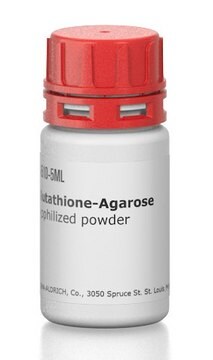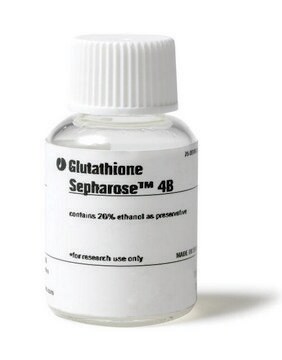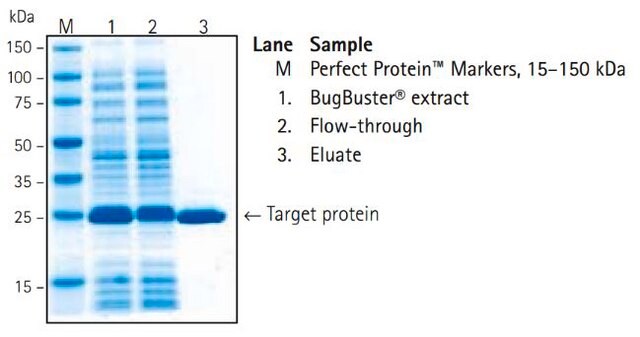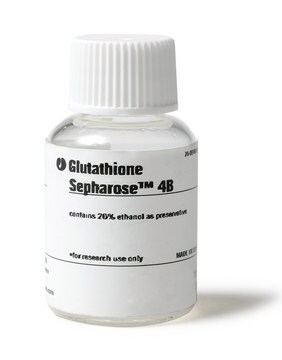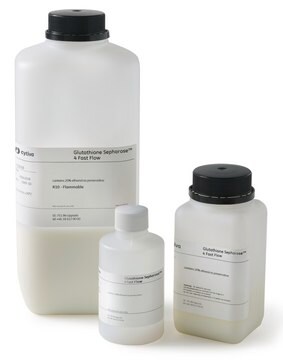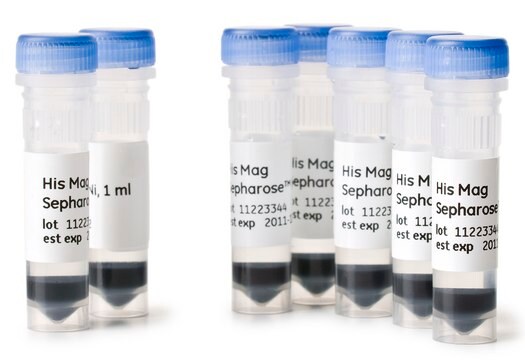G0924
Glutathione High Capacity Magnetic Agarose Beads
(1:1 suspension in a 30% ethanol solution)
Synonym(s):
Magnetic agarose beads
About This Item
Recommended Products
conjugate
magnetic beads
Quality Level
form
(1:1 suspension in a 30% ethanol solution)
analyte chemical class(es)
proteins (GST)
technique(s)
immunoprecipitation (IP): suitable
protein purification: suitable
matrix
4% beaded magnetic agarose
matrix spacer
12 atoms
capacity
≥15 μmol/mL, agarose binding capacity
shipped in
wet ice
storage temp.
2-8°C
Looking for similar products? Visit Product Comparison Guide
General description
The Glutathione Magnetic Agarose Beads are useful for affinity capture, molecular pull-down, or immunoprecipitation (IP) of proteins containing glutathione binding sequences, such as native glutathione S-transferase (GST), glutathione peroxidase, and glyoxalase I, or GST-tagged recombinant fusion proteins from cell lysates or other biochemical solutions while exhibiting low non-specific binding of other proteins. Recombinant GST-tagged proteins, bound to the affinity resin are separated with the use of a magnet. The magnetic properties allow for very rapid processing, as well as aid in manipulations, such as repetitive washings and recovery of the desired protein. This leads to faster recovery, experimental reproducibility, and more accurate quantitation of the proteins of interest.
The matrix of the magnetic beads is a 4% beaded agarose with an average diameter of 50 μ and a diameter range of 20-75 μ. Paramagnetic iron is impregnated within the beads.
Application
Physical form
Signal Word
Danger
Hazard Statements
Precautionary Statements
Hazard Classifications
Flam. Liq. 2
Storage Class Code
3 - Flammable liquids
WGK
WGK 2
Certificates of Analysis (COA)
Search for Certificates of Analysis (COA) by entering the products Lot/Batch Number. Lot and Batch Numbers can be found on a product’s label following the words ‘Lot’ or ‘Batch’.
Already Own This Product?
Find documentation for the products that you have recently purchased in the Document Library.
Customers Also Viewed
Related Content
Pull-down assays, reagents, and protocols for investigating in vitro protein-protein interactions using affinity or GST pull-down, tandem affinity purification (TAP), and co-immunoprecipitation methods.
Our team of scientists has experience in all areas of research including Life Science, Material Science, Chemical Synthesis, Chromatography, Analytical and many others.
Contact Technical Service